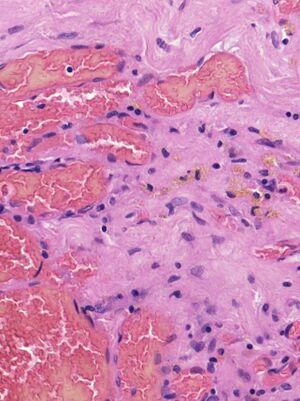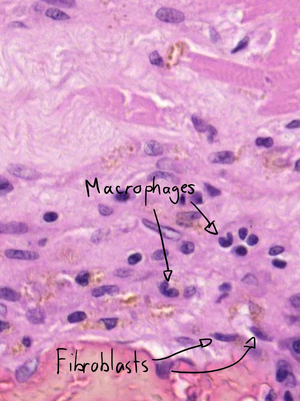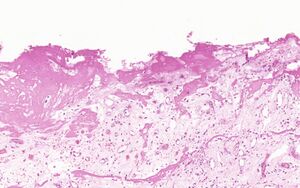32. Myocardial infarct with organisation: Difference between revisions
(Created page with "'''Staining''': HE '''Organ''': Myocardium '''Description''': We can see four parts of the myocardium with different morphology. We’ll divide them into four zones to make explanation easier. See the figure below to see the different zones. The first zone is at the bottom of the slide. Here we can see the three typical signs of myocardial hypertrophy: enlarged nuclei, increased lipofuscin and interstitial fibrosis. The second zone is the bulk of the slide. Here we...") |
No edit summary |
||
| Line 1: | Line 1: | ||
'''Staining''': HE | [[File:Myocardial infarct with organisation.jpg|thumb|Overview with the different zones]]'''Staining''': HE | ||
'''Organ''': Myocardium | '''Organ''': Myocardium | ||
| Line 11: | Line 11: | ||
The second zone is the bulk of the slide. Here we can see the lack of nuclei. | The second zone is the bulk of the slide. Here we can see the lack of nuclei. | ||
The third zone is between the first and second zones and between the second and fourth zones. Here we can see many vessels containing RBCs, as well as fibroblasts and fibrosis. | The third zone is between the first and second zones and between the second and fourth zones. Here we can see many vessels containing RBCs, as well as fibroblasts and fibrosis.[[File:Myocardial infarct with organisation zone 1.jpg|thumb|From zone 1. Note also the lipofuscin and interstitial fibrosis on the bottom left.]]The fourth zone is in the upper left corner. Here we can see some eosinophilic hyaline substance. | ||
The fourth zone is in the upper left corner. Here we can see some eosinophilic hyaline substance. | |||
'''Diagnosis''': Myocardium in recent phase with organization | '''Diagnosis''': Myocardium in recent phase with organization | ||
| Line 21: | Line 19: | ||
* See macropreparation 2 | * See macropreparation 2 | ||
'''Theory''': | '''Theory''':[[File:Myocardial infarct with organisation zone 2.jpg|thumb|From zone 2. Note the lack of nuclei.]]The first zone was untouched by the infarct but is hypertrophied. Hypertrophy could have been an important factor in the infarct. | ||
The first zone was untouched by the infarct but is hypertrophied. Hypertrophy could have been an important factor in the infarct. | |||
The second zone is where the infarct happened. Necrosis is visible due to the lack of nuclei. | The second zone is where the infarct happened. Necrosis is visible due to the lack of nuclei. | ||
| Line 32: | Line 28: | ||
Organization is seen in the recent phase (from 1-2 days to 1 week) of myocardial infarct. | Organization is seen in the recent phase (from 1-2 days to 1 week) of myocardial infarct. | ||
[[File:Myocardial infarct with organisation zone 3.jpg|thumb|From zone 3. Note the many vessels containing blood.|left]] | |||
[[File:Myocardial infarct with organisation zone 3 fibroblasts.png|thumb|From zone 3. Fibrosis can be seen on the top of the slide.]] | |||
[[File:Myocardial infarct with organisation zone 4.jpg|thumb|From zone 4. The eosinophilic substance is fibrin.|left]] | |||
[[File:Myocardial infarct with organisation zone 3.jpg | |||
[[File:Myocardial infarct with organisation zone 3 fibroblasts.png | |||
[[File:Myocardial infarct with organisation zone 4.jpg | |||
[[Category:Pathology 1 - Histopathology slides]] | [[Category:Pathology 1 - Histopathology slides]] | ||
Latest revision as of 12:06, 5 July 2024

Staining: HE
Organ: Myocardium
Description:
We can see four parts of the myocardium with different morphology. We’ll divide them into four zones to make explanation easier. See the figure below to see the different zones.
The first zone is at the bottom of the slide. Here we can see the three typical signs of myocardial hypertrophy: enlarged nuclei, increased lipofuscin and interstitial fibrosis.
The second zone is the bulk of the slide. Here we can see the lack of nuclei.
The third zone is between the first and second zones and between the second and fourth zones. Here we can see many vessels containing RBCs, as well as fibroblasts and fibrosis.
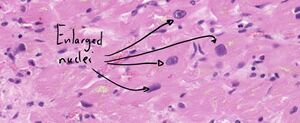
The fourth zone is in the upper left corner. Here we can see some eosinophilic hyaline substance.
Diagnosis: Myocardium in recent phase with organization
Causes:
- See macropreparation 2
Theory:
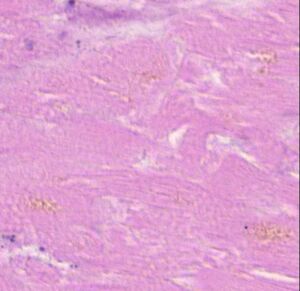
The first zone was untouched by the infarct but is hypertrophied. Hypertrophy could have been an important factor in the infarct.
The second zone is where the infarct happened. Necrosis is visible due to the lack of nuclei.
The third zone is where organization happens. Organization is part of the healing process after an infarct. During organization the necrotic tissue is replaced by an ingrowth of fibroblasts and vessels. In the background we can see beginning of fibrosis as well. The leukocytes that are present are neutrophils and macrophages. They digest the necrotic tissues to make way for the fibroblasts to make fibrosis.
The fourth zone is of the visceral pericardium. Here we can see an eosinophilic hyaline substance that is fibrin. It shows the beginning of fibrous pericarditis that occurs due to the myocardial infarct.
Organization is seen in the recent phase (from 1-2 days to 1 week) of myocardial infarct.
